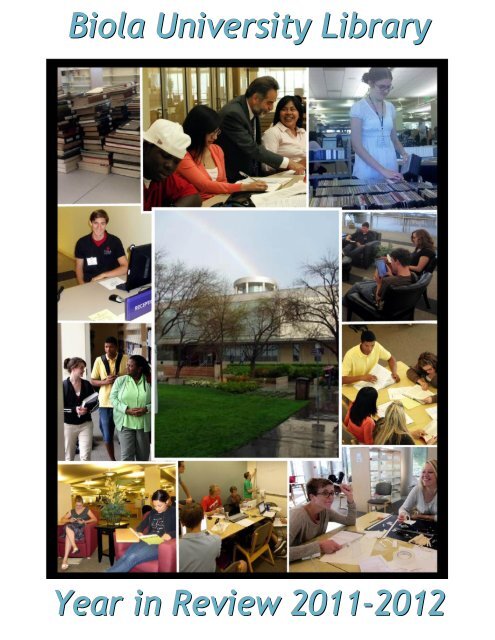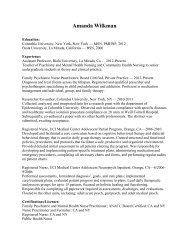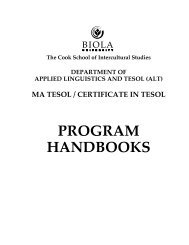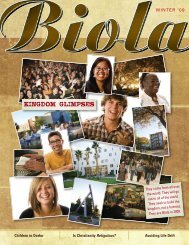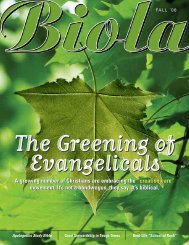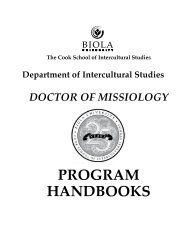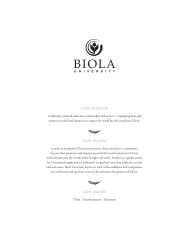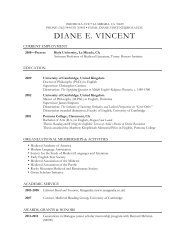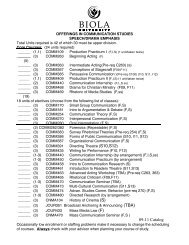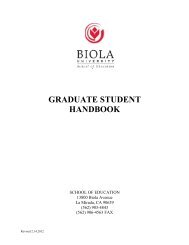Library Annual Report, 2011-2012 - Biola University
Library Annual Report, 2011-2012 - Biola University
Library Annual Report, 2011-2012 - Biola University
Create successful ePaper yourself
Turn your PDF publications into a flip-book with our unique Google optimized e-Paper software.
<strong>Biola</strong> <strong>University</strong> <strong>Library</strong><br />
Year in Review <strong>2011</strong>-<strong>2012</strong><br />
i
TABLE OF CONTENTS<br />
YEAR IN REVIEW <strong>2011</strong>-<strong>2012</strong> ......................................................................... 1<br />
KEY ACHIEVEMENTS ................................................................................... 2<br />
LIBRARY BUILDING USE .............................................................................. 4<br />
REFERENCE AND INSTRUCTION SERVICES ............................................. 6<br />
ACCESS SERVICES ...................................................................................... 9<br />
DOCUMENT DELIVERY SERVICES ............................................................ 11<br />
MEDIA SERVICES ........................................................................................ 12<br />
COLLECTION MANAGEMENT .................................................................... 14<br />
ELECTRONIC RESOURCES ....................................................................... 15<br />
LIBRARY SERVICES USER SURVEY ......................................................... 17<br />
i
YEAR IN REVIEW <strong>2011</strong>-<strong>2012</strong><br />
This year the <strong>Biola</strong> <strong>Library</strong> expanded the Information Commons area by adding<br />
additional seating/computer capacity on the main level. The <strong>Library</strong> recently launched a<br />
mobile version of the library website. It includes mobile-friendly interfaces for some of<br />
the library’s most used resources, such as the library webcatalog, your library account,<br />
Ask a Librarian, and LibGuides. Over one-third of the library’s databases can now be<br />
searched via a mobile-friendly interface.<br />
The <strong>Library</strong>, in collaboration with the Department of Art, continues to be available as a<br />
venue for art and special exhibitions, which enhances the library environment for<br />
learning and discovery. Last semester’s exhibition featured The Nautical & Theological<br />
Paintings of Marcus Paulsen. In addition, the <strong>Library</strong> housed two of <strong>Biola</strong>’s Year of the<br />
Arts special events: (1) a design charrette where selected students worked with leading<br />
architects to design an outdoor chapel for Orange County Rescue Mission’s ranch (as<br />
well as explore the crucial theme of Sacred Spaces), and (2) a filmed interview of USC<br />
Poetry Professor and Former Chairman of the National Endowment for the Arts, Dana<br />
Gioia.<br />
We are now in a period of transition as we look for a new <strong>Library</strong> Dean. After 20 years<br />
of distinguished service, Dr. Rodney Vliet retired in December <strong>2011</strong>.<br />
What if we considered times of transition as more<br />
than merely 'in between' times? What if we<br />
recognized transitions as especially strategic and<br />
noteworthy occasions when God chooses to make<br />
Himself known?<br />
Transition times encourage us to keep our eyes<br />
open to what God is doing here and now, as well as<br />
what God has done before and what God will do<br />
next. "Making all things new' is the transitional<br />
context that informs, anchors, and enriches every<br />
transitional season. Transitions call for testimony:<br />
'Surely, the Lord is in this place!' (Rev. Cecil van<br />
Niejenhuis, Banner, Feb. <strong>2012</strong> p. 7)<br />
Our mission continues to be to support biblically centered education and the integration<br />
of faith and learning at <strong>Biola</strong> by providing access to all forms of information and<br />
recorded knowledge.<br />
Please read on to learn more about our staff, services, and collections. And as always,<br />
let us know how we can serve you better!<br />
Sincerely,<br />
Sue Whitehead and John Redford<br />
Interim Co-Directors<br />
1
KEY ACHIEVEMENTS<br />
Obsolete print indexes were replaced by online databases and the space has<br />
been used for the addition of 38 computer-equipped study stations. These, and<br />
other public workstations throughout the <strong>Library</strong>, replace those in the former<br />
Welch computer lab in Metzger.<br />
The electronic book collection is now larger than the regular book collection (over<br />
200000 titles).<br />
We have access to over 42,000 online and print journals.<br />
Question Point online reference service, i.e. a “chat” service has been<br />
implemented.<br />
Mobile access to the library catalog is available.<br />
A <strong>Biola</strong> <strong>Library</strong> Digital Archive has been created to provide online access to<br />
choice items from the Archives.<br />
Other statistics:<br />
Over 12,500 items in <strong>2011</strong>-<strong>2012</strong> borrowed through Interlibrary Loan and Link+<br />
reciprocal borrowing services.<br />
140,531 items checked out in <strong>2011</strong>-<strong>2012</strong> (over 30,000 self-check-outs)<br />
71,878 gate entries in the month of October, <strong>2011</strong><br />
4,088 total LibGuide visits<br />
120 library instruction sessions, reaching 2,340 students<br />
136,853 ebook titles added to the library catalog<br />
4,603 monograph titles added to the library catalog<br />
643,267 <strong>Library</strong> homepage hits<br />
1,227,860 <strong>Library</strong> website page views<br />
3,363 average page views per day from library website<br />
56.07% returning visitors to library website<br />
43.93% new visitors to library website<br />
2
The <strong>Biola</strong> <strong>Library</strong> is a member of the following consortia:<br />
SCELC – Statewide California Electronic <strong>Library</strong> Consortium<br />
CLC – Christian <strong>Library</strong> Consortium<br />
OCLC – Online Computer <strong>Library</strong> Center<br />
ATLA – American Theological <strong>Library</strong> Association<br />
SCATLA – Southern California Theological Association<br />
WALDO – Westchester Academic <strong>Library</strong> Director’s Organization<br />
Link+ - reciprocal borrowing consortium<br />
WEST – Western Regional Storage Trust<br />
IEALC – Inland Empire Academic Libraries Cooperative<br />
Such partnerships allow the consortia libraries to benefit in substantial savings on<br />
electronic purchases and subscriptions, and through the sharing of resources. Being a<br />
member also helps other libraries who may be smaller than the <strong>Biola</strong> <strong>Library</strong>.<br />
3
LIBRARY BUILDING USE<br />
Number of Patrons per Month<br />
80,000<br />
70,000<br />
60,000<br />
50,000<br />
40,000<br />
30,000<br />
20,000<br />
10,000<br />
0<br />
66,753<br />
<strong>Library</strong> Use<br />
71,878<br />
67,782<br />
46,015<br />
58,955<br />
63,926<br />
70,739<br />
Jul Aug Sept Oct Nov Dec Jan Feb Mar Apr May Jun<br />
2009-2010<br />
2010-<strong>2011</strong><br />
<strong>2011</strong>-<strong>2012</strong><br />
The <strong>Library</strong> was originally built to accommodate approximately 800 students at one<br />
time. In the late 1990s, the total student body was expected to grow to about 4,000<br />
students. The above graph shows the direct ratio of increased student population with<br />
an increase usage of study space. The <strong>Library</strong> is currently housing about 850 study<br />
seats but needs to grow to 1,200 seats (based on current enrollment of 6,000). In<br />
<strong>2012</strong>, the middle level reduced its shelving area and expanded the Information<br />
Commons. This gave the students some additional seating/study space.<br />
4
Development of the Information Commons:<br />
* first year in new library<br />
Year No. of Public Stations (all floors)<br />
PCs Macs Total Public Stations<br />
2001* 58 0 58<br />
2008** 66 0 66<br />
2010*** 66 20 86<br />
<strong>2011</strong>**** 96 32 128<br />
** addition of two pinwheels on ML<br />
*** addition of Macs to UL and LL circles<br />
**** removal of indexes and expansion of ML commons with addition of new tables<br />
From opening day in 2001 to the present, the <strong>Library</strong> has seen a 220% growth in the<br />
number of computer workstations available for student use. Despite this significant<br />
increase and the widespread availability of wireless access for personal laptops, during<br />
peak times of the semester there are not enough workstations to meet our students’<br />
needs.<br />
5
REFERENCE AND INSTRUCTION SERVICES<br />
The Reference and Instruction Department provides assistance to students, staff,<br />
faculty, and other community patrons in completing class assignments, doing research,<br />
and accessing appropriate resources. We reach library users through a number of<br />
access points, including the Reference Desk, student classrooms, staff offices, online<br />
chat, phone, and email.<br />
The library implemented LibStats in 2009 in order to track basic statistics about<br />
transactions, to create a record of the questions and answers, and to create a<br />
knowledge base of answers to the questions. Students ask the most questions (78-<br />
90%) of library staff each year. Alumni and guests ask more questions (6-12%) than<br />
staff and faculty (3-4%). The majority of questions are asked on Monday – Thursday<br />
between the hours of 12 – 6 pm.<br />
Number of questions<br />
16000<br />
14000<br />
12000<br />
10000<br />
8000<br />
6000<br />
4000<br />
2000<br />
0<br />
Total Reference Queries<br />
2009/10 2010/11 <strong>2011</strong>/12<br />
6
Librarians provide library instruction sessions in which they teach research techniques<br />
that will enable students and faculty to find information more effectively and develop a<br />
systematic method of research that can be applied to any assignment. Usually the fall<br />
semesters have the most instruction sessions with the heaviest month being<br />
September. However, since the creation of online research guides (LibGuides), fewer<br />
First Year Seminar sessions were requested during the fall semester.<br />
Number of Sessions<br />
50<br />
40<br />
30<br />
20<br />
10<br />
0<br />
<strong>Library</strong> Instruction Sessions<br />
Jul Aug Sept Oct Nov Dec Jan Feb Mar Apr May Jun<br />
2009/10 2010/11 <strong>2011</strong>/12<br />
<strong>Library</strong> RSAs (Reference Services<br />
Assistants) are a valuable part of the<br />
Reference team. These student workers<br />
have been trained by librarians to<br />
provide assistance at the Reference<br />
Desk and to answer most common<br />
library questions. While at the<br />
Reference Desk, they also staff the Ask<br />
a Librarian service, which includes<br />
answering online chat questions from<br />
users.<br />
7
LibGuides<br />
LibGuides are online research guides that include video tutorials and resources specific<br />
to a class, major, or discipline. The <strong>2011</strong> Fall semester was the first time LibGuides<br />
were available. The first guide was designed for students in the First Year Seminar<br />
class and provided an introduction to the library and its resources. This guide received<br />
2,000 hits in the month of September. Over the course of the school year we added<br />
additional guides, including subject guides and video tutorials demonstrating search<br />
techniques. History is the most used subject guide, followed by English. This year we<br />
published a total of 10 LibGuides. LibGuide visits for this past school year were 4,088!<br />
As we create new guides, we will continue to consult with faculty and students to ensure<br />
that these LibGuides support course curriculum and student learning outcomes. We<br />
continue to work toward creating guides for classes that are scheduled each semester<br />
(i.e., Nursing, Theological Research Methods).<br />
8
ACCESS SERVICES<br />
Access Services facilitates the physical access of library materials through lending<br />
services points such as the Circulation/Reserves desk, resource sharing via Link+ and<br />
Interlibrary Loan services, and by ensuring quick turnaround time for shelving of library<br />
materials. Other services include: collecting fees, sending circulation notices, access to<br />
reserve materials, issuing library cards, and opening/closing the <strong>Library</strong>. Access<br />
Services also provides patrons with assistance at the <strong>Library</strong> entrance, and library card<br />
applications are processed for Alumni and community patrons, including students from<br />
reciprocal institutions. Activities for the past academic year are as noted below.<br />
Circulation:<br />
The physical collection usage is reflected in the statistics from checkout and in-house<br />
use. Students requested a longer checkout period and more renewals, which were put<br />
into effect for the <strong>2011</strong>-<strong>2012</strong> academic year. This change in circulation policy has led to<br />
a decrease in the number of checkouts because the patron can keep the materials<br />
longer. In addition, the implementation of due date alert notices via email to remind<br />
patrons to return their materials on time has worked well. More materials are returned<br />
on time, and fewer fines are being charged to patrons. It is also important to note that<br />
there is an increase in the use of electronic resources, which is not recorded as<br />
circulation activity.<br />
2010-<strong>2011</strong> <strong>2011</strong>-<strong>2012</strong><br />
Checkout: 144,263 140,531<br />
Checkin: 122,631 117,225<br />
In-house use 54,794 68,789<br />
A subset to the above checkout figures is the self service checkout machine. It allows a<br />
patron to do his own checkout of materials.<br />
Self Service Checkouts:<br />
Total<br />
Sessions<br />
Total<br />
Checkouts<br />
Average Patron<br />
Use/Day<br />
Average<br />
Items/Day<br />
2010-<br />
<strong>2011</strong> <strong>2011</strong>-<strong>2012</strong><br />
15,880<br />
32,357<br />
44<br />
89<br />
14,215<br />
33,333<br />
39<br />
91<br />
9
Number of items<br />
Reserve transaction activity:<br />
20000<br />
15000<br />
10000<br />
5000<br />
0<br />
2010-<strong>2011</strong> <strong>2011</strong>-<strong>2012</strong><br />
Reserves 12,509 13,432<br />
E-reserves (pages viewed) 11,904 13,919<br />
Checkout of reserve materials has increased this past year by about 7%. In addition, the<br />
use of electronic reserves has increased by 17%. The library adds more electronic<br />
reserves as more courses/programs move into the online environment.<br />
Stacks Management:<br />
July<br />
Aug<br />
Sept.<br />
Oct.<br />
Nov.<br />
Dec.<br />
Jan.<br />
Feb.<br />
Mar.<br />
Apr.<br />
May<br />
Jun<br />
shelving 2010/11 shelving <strong>2011</strong>/12<br />
Number of items<br />
14000<br />
12000<br />
10000<br />
8000<br />
6000<br />
4000<br />
2000<br />
0<br />
July<br />
Aug<br />
Sept.<br />
Oct.<br />
Nov.<br />
Dec.<br />
Jan.<br />
Feb.<br />
Mar.<br />
Apr.<br />
May<br />
Jun<br />
reshelving 2010/11 reshelving <strong>2011</strong>/12<br />
10
DOCUMENT DELIVERY SERVICES<br />
Number of items<br />
Number of items<br />
3500<br />
3000<br />
2500<br />
2000<br />
1500<br />
1000<br />
500<br />
0<br />
10500<br />
10000<br />
9500<br />
9000<br />
8500<br />
Link+<br />
2010-<strong>2011</strong> <strong>2011</strong>-<strong>2012</strong><br />
<strong>Biola</strong> patrons have another resource for their research. <strong>Biola</strong><br />
belongs to the Link+ Consortium which allows a <strong>Biola</strong> patron<br />
to request a book from another Link+ member library. The<br />
books are delivered within 2-3 days via a courier system. In<br />
the past year <strong>Biola</strong> <strong>Library</strong>’s Link+ borrowing increased by<br />
10% and our lending increased by 2%.<br />
Books and journal articles which are not available at <strong>Biola</strong> or<br />
at the Link+ libraries are requested through inter-library loan.<br />
The inter-library loan network is nationwide. <strong>Biola</strong> patrons’<br />
borrowing requests increased by about 121% this past year.<br />
In addition, our fulfillment rate to other libraries’ requests<br />
reflects a 3% increase this past year.<br />
Inter-<strong>Library</strong> Loan<br />
2010-<strong>2011</strong> <strong>2011</strong>-<strong>2012</strong><br />
Borrow<br />
Lend<br />
Borrow<br />
Lend<br />
11
MEDIA SERVICES<br />
Media Services supports the creation and use of multimedia in education, scholarship,<br />
and creative expression. We provide services that assist with digital projects and<br />
access to the essential tools for creating and presenting digital resources such as digital<br />
video and audio, including PowerPoint presentations.<br />
.<br />
<strong>2011</strong>/12<br />
2010/11<br />
# of Equipment Orders<br />
0 500 1000 1500 2000 2500<br />
This chart represents equipment use and does not include services.<br />
Each order may require setting up many pieces of equipment to work together.<br />
12
This past year the number of equipment orders has<br />
grown by 30%. Media Services provides equipment<br />
and/or services to almost every <strong>Biola</strong> <strong>University</strong><br />
department, such as Admissions, Torrey & Missions<br />
Conference, Youth Arts, Events, etc... In addition,<br />
almost all of the departments require CD or DVD<br />
duplication, analog to digital transfers as well as CD<br />
editing or digitizing audio.<br />
Services include: providing short-term checkout of equipment such as digital projectors,<br />
laptops, video and sound equipment. Delivery of classroom and event hardware<br />
configuration carts is available. In addition, we also offer video and audio editing,<br />
scanning of various media, duplication of CD, DVD and Blu-Ray disks, CD and DVD<br />
mastering, and transfers of video and audio analog to digital.<br />
1200<br />
1000<br />
800<br />
600<br />
400<br />
200<br />
0<br />
Projector Sound<br />
Equipment<br />
# of Checkouts<br />
Video<br />
Equipment<br />
Computer Misc.<br />
2010/11<br />
<strong>2011</strong>/12<br />
Staff leadership at the Media Services strives to remain up-to-date with emerging<br />
technologies, as well as to understand transformation in how scholars conduct and<br />
disseminate research.<br />
13
COLLECTION MANAGEMENT<br />
42%<br />
<strong>2011</strong>-<strong>2012</strong> <strong>Library</strong> Collection by Title<br />
9%<br />
1% 1% 2%<br />
45%<br />
Print<br />
E-Book<br />
E-Journal<br />
Print Journal<br />
Scores<br />
Media<br />
The pie chart shows the percentage of titles in each format. In recent years electronic<br />
books and journals have grown. This will be especially beneficial for the <strong>Biola</strong> Global<br />
Programs.<br />
Number of Titles<br />
300000<br />
250000<br />
200000<br />
150000<br />
100000<br />
50000<br />
0<br />
Growth of Electronic versus Print<br />
Collections over 5 Years<br />
2007-2008 2008-2009 2009-2010 2010-<strong>2011</strong> <strong>2011</strong>-<strong>2012</strong><br />
Print Electronic<br />
14
ELECTRONIC RESOURCES<br />
Usage statistics for downloading of electronic articles and for searching in databases<br />
are summarized below. This does not constitute a complete report of all usage for all<br />
electronic journals/databases because it is not yet possible for us to track every single<br />
electronic item. For the most part these statistics are COUNTER-compliant.<br />
(COUNTER is a standardized code of practice for reporting usage statistics.)<br />
<strong>2011</strong>-<strong>2012</strong><br />
2010-<strong>2011</strong><br />
*This figure reflects articles downloaded from major ejournal packages and databases. It<br />
does not include articles from individually subscribed ejournals or some of our smaller full<br />
text databases.<br />
Some highlights from our ejournal<br />
packages and database usage<br />
reports:<br />
Patron searching has increased<br />
21% over last year<br />
Download of articles has<br />
increased 15% over last year<br />
In addition the number of<br />
search sessions has increased<br />
18% from last year<br />
Articles downloaded*<br />
150000 160000 170000 180000 190000 200000<br />
700000<br />
600000<br />
500000<br />
400000<br />
300000<br />
200000<br />
100000<br />
0<br />
Number of Searches<br />
2010-<strong>2011</strong> <strong>2011</strong>-<strong>2012</strong><br />
15
The number of ebooks available to our patrons has grown exponentially over the past<br />
five years. The following chart reflects recent ebook usage.<br />
25000<br />
20000<br />
15000<br />
10000<br />
5000<br />
0<br />
# of ebooks Used<br />
2010/11 <strong>2011</strong>/12<br />
The number of ebook searches increased by about 28% in the last two years. The<br />
library acquired 11% more ebooks than print books this past year. The acquisition of<br />
ebooks allows the <strong>Biola</strong> <strong>Library</strong> to expand its collection of subject matter; to provide<br />
resources for students in the distance learning programs; and to supplement the<br />
physical collection of print books in the current library building.<br />
16
LIBRARY SERVICES USER SURVEY<br />
In November <strong>2011</strong>, Reference and Instruction librarians conducted a survey of students,<br />
staff, faculty and other members of the <strong>Biola</strong> community. The goal of the survey was to<br />
collect data that would guide us in developing and enhancing the library's resources and<br />
level of service.<br />
We received 1,648 total completed responses over a three-week period using<br />
SurveyMonkey. A few significant findings from our survey included:<br />
66.3% of all respondents and 76% of undergraduates access the library in<br />
person at least weekly.<br />
Most respondents (75.6%) were satisfied with the current open library hours.<br />
The majority of respondents most often visit the library to study (79.7%), check<br />
out library materials (69.8%), print a document (41.8%), and access a computer<br />
(38.2%).<br />
Respondents overwhelmingly stated a need for more study spaces in the library.<br />
In the chart below, the top two responses were requests for more group spaces<br />
(68.7%) and individual spaces (59.0%) within the library. Undergraduate<br />
respondents requested group spaces even more (81.8%).<br />
17
14.2% of respondents indicated that library desks, chairs, and couches are not<br />
available when they need them. Likewise, our data showed that over half (52.7%)<br />
of respondents who use study rooms indicated that group study rooms are not<br />
available when they need them.<br />
When we asked respondents, “What do you value most about the library?”<br />
almost 90% gave an optional open-ended response. Most responses related to<br />
the study spaces and atmosphere, the resources, services, and the building<br />
itself.<br />
18


